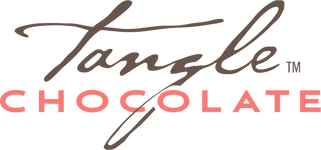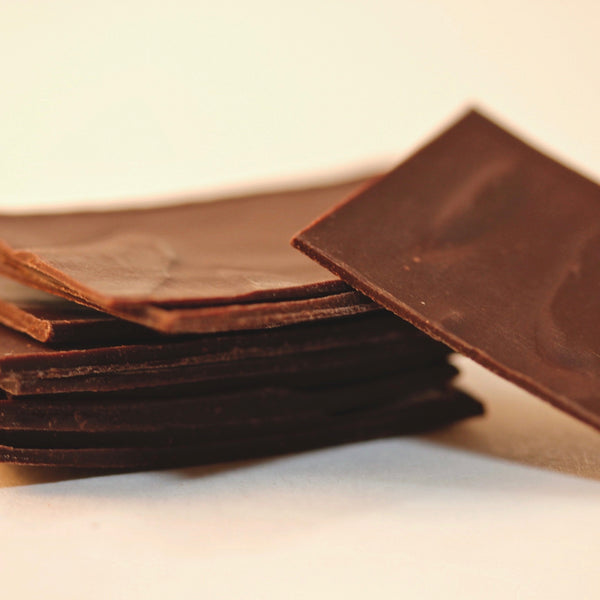A SLIVER-SIZED HISTORY OF CHOCOLATE
Jul 23, 2020
When we think about chocolate, we imagine a sweet treat, whether it be a bar or a box of truffles. But for most of its history, chocolate wasn’t prepared with sugar, nor was it eaten, rather it was drunk as a beverage. The whole story of chocolate fills volumes of fascinating books. This is the condensed history that you can read in just about the amount of time that it takes to savor a Tangle Chocolate Thin.
The origin of the word “chocolate” can be traced to the Aztec word “xocolatl” which was a bitter drink made using cacao beans. It was often used in religious rituals or for medicinal purposes, as it was believed to be an aphrodisiac and gave the drinker strength.
Cacao, the main ingredient in chocolate, can be traced back to around 10,000 BCE in the Amazon Rainforest, when it is believed to have diverged from its most recent common ancestor into the species Theobroma Cacao. Early Mesoamericans mark the invention of maize and cacao on ‘Day One.’ They believed that cacao seeds (which we call beans) were a gift from the gods and valued cacao so highly that the beans were even used as a form of currency.
Chocolate seems to have made its way to North America by 770 CE according to ancient vessels found near present-day Utah that contain traces of cacao. It wasn’t until the 16th century that Europeans learned of cacao, when Christopher Columbus intercepted an indigenous ship that contained cacao beans during his fourth voyage to the Americas in 1502. Hernan Cortes, a Spanish conquistador, first encountered xocolatl in the court of Montezuma, the ruler of the Aztec Empire. Following the fall of the Aztecs due to the Spanish Conquest in 1519, the Spaniards began importing cacao to Europe. There, it was still served as a beverage but with the addition of sugar or honey to create a sweet treat. Over the next century, “xocolatl” turned into “chocolate,” and a new craze for chocolate began.
As the popularity of chocolate rose in Europe, so began a prosperous market for slavery. In the early 17th century, the Middle Passage began which sent enslaved peoples from Africa to the Caribbean and South America to work in cotton, sugar and cacao plantations. This shift of production zones from Mesoamerica to the coast of South America and the Caribbean was caused by demographic changes, disease and overproduction which decimated Mesoamerican cacao. While slavery in the Americas was occurring during this time, the English, Dutch and French also held cacao plantations in Africa where they used the labor of enslaved people to manually process cacao. Today, West Africa is still responsible for supplying 70% of the world’s cacao.
During the Industrial Revolution, new processes were invented that allowed for the mass production of chocolate. In 1815, Coenraad van Houten, a Dutch chemist, began adding alkaline salts to chocolate to reduce its bitterness. Van Houten then went on to patent a press which separated the natural fat (cocoa butter) found in roasted cacao beans. The press produced chocolate that was consistent in quality at a lower price. This method created chocolate that is known as “Dutch cocoa.”
In 1847, Joseph Fry realized that by adding melted cocoa butter into the roasted ground cacao beans, he was able to create a chocolate solid that was moldable. This marked the transition of chocolate from a bitter drink to a chocolate bar as we know it. This invention was further transformed when Daniel Peter added powdered milk into ground cacao to create milk chocolate. Though milk had long been added to drinking chocolate, this was the first time that a milk chocolate bar was available.
In the late 19th and 20th century, the manufacturing of chocolate became largely commercialized with many of the current corporations starting during this time in the United States and Europe. Due to the improvement of processing machinery that allowed chocolate to be mass produced, the price of chocolate fell. This shifted the trend of chocolate from a commodity of the rich elite to one that can be enjoyed by all of society.
The advent of the bean-to-bar industry is generally credited to John Scharffenberger, a winemaker who turned to chocolate making in 1996. While Scharffenberger deserves credit for getting bean-to-bar chocolate noticed, bean-to-bar chocolate has always been made all over the world, primarily by people of color for whom bean-to-bar chocolate is part of their heritage and everyday lives. Today, there are well over 200 bean-to-bar chocolate companies in the US alone, including Tangle Chocolate. While we account for a tiny percentage of the world’s $130 billion chocolate industry, our market share is growing alongside consumers’ knowledge and preference for this fine quality, delicious food of the gods!
Sources:
https://www.history.com/topics/ancient-americas/history-of-chocolate
https://www.smithsonianmag.com/arts-culture/a-brief-history-of-chocolate-21860917/


